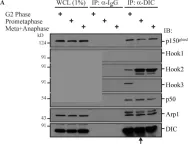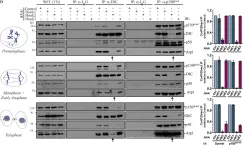The cellular distribution of mitochondria in response to stress and local energy needs is governed by the relative activities of kinesin and dynein. The mechanism for switching between these two opposite polarity microtubule motors remains unknown. Here, we coupled a novel cellular synthetic cargo transport assay with AlphaFold2-guided mutagenesis to identify a regulatory helix in the mitochondrial adaptor protein (TRAK) that mediates switching between kinesin- and dynein-driven transport. Differences in the helix sequence explain why two near-identical TRAK isoforms transport mitochondria in predominantly opposite directions. Phosphorylation of the regulatory helix by stress-activated kinases causes the activation of dynein and dissociation of kinesin. Our results reveal a molecular mechanism for coordinating the directional transport of mitochondria in response to intracellular signals.
Product Citations: 17
A molecular switch for stress-induced activation of retrograde mitochondrial transport
Preprint on BioRxiv : the Preprint Server for Biology on 14 September 2024 by Gladkova, C., Paez-Segala, M. G., et al.
-
Cell Biology
Human dynein-dynactin is a fast processive motor in living cells
Preprint on BioRxiv : the Preprint Server for Biology on 29 November 2023 by Verma, V., Wadsworth, P., et al.
ABSTRACT Minus-end directed transport along microtubules in eukaryotes is primarily mediated by cytoplasmic dynein and its cofactor dynactin. Significant advances have been made in recent years characterizing human dynein-dynactin structure and function using in vitro assays, however, there is limited knowledge about the motile properties and functional organization of dynein-dynactin in living human cells. Total internal reflection fluorescence microscopy (TIRFM) of CRISPR-engineered human cells is employed here to visualize fluorescently tagged dynein heavy chain (DHC) and p50 with high spatio-temporal resolution. We find that p50 and DHC exhibit indistinguishable motility properties in their velocities, run lengths, and run times. The dynein-dynactin complexes are fast (∼1.2 μm/s) and typically run for several microns (∼2.7 μm). Quantification of the fluorescence intensities of motile puncta reveals that dynein-dynactin runs are mediated by at least one DHC dimer while the velocity is consistent with that measured for double dynein (two DHC dimers) complexes in vitro.
-
WB
-
Homo sapiens (Human)
In NPJ Parkinson's Disease on 7 March 2023 by Yu, J., Yang, X., et al.
Multiple missense mutations in p150Glued are linked to Perry syndrome (PS), a rare neurodegenerative disease pathologically characterized by loss of nigral dopaminergic (DAergic) neurons. Here we generated p150Glued conditional knockout (cKO) mice by deleting p150Glued in midbrain DAergic neurons. The young cKO mice displayed impaired motor coordination, dystrophic DAergic dendrites, swollen axon terminals, reduced striatal dopamine transporter (DAT), and dysregulated dopamine transmission. The aged cKO mice showed loss of DAergic neurons and axons, somatic accumulation of α-synuclein, and astrogliosis. Further mechanistic studies revealed that p150Glued deficiency in DAergic neurons led to the reorganization of endoplasmic reticulum (ER) in dystrophic dendrites, upregulation of ER tubule-shaping protein reticulon 3, accumulation of DAT in reorganized ERs, dysfunction of COPII-mediated ER export, activation of unfolded protein response, and exacerbation of ER stress-induced cell death. Our findings demonstrate the importance of p150Glued in controlling the structure and function of ER, which is critical for the survival and function of midbrain DAergic neurons in PS.
© 2023. The Author(s).
-
WB
-
Mus musculus (House mouse)
-
Cell Biology
-
Neuroscience
Phosphorylation and Pin1 binding to the LIC1 subunit selectively regulate mitotic dynein functions.
In The Journal of Cell Biology on 6 December 2021 by Kumari, A., Kumar, C., et al.
The dynein motor performs multiple functions in mitosis by engaging with a wide cargo spectrum. One way to regulate dynein's cargo-binding selectivity is through the C-terminal domain (CTD) of its light intermediate chain 1 subunit (LIC1), which binds directly with cargo adaptors. Here we show that mitotic phosphorylation of LIC1-CTD at its three cdk1 sites is required for proper mitotic progression, for dynein loading onto prometaphase kinetochores, and for spindle assembly checkpoint inactivation in human cells. Mitotic LIC1-CTD phosphorylation also engages the prolyl isomerase Pin1 predominantly to Hook2-dynein-Nde1-Lis1 complexes, but not to dynein-spindly-dynactin complexes. LIC1-CTD dephosphorylation abrogates dynein-Pin1 binding, promotes prophase centrosome-nuclear envelope detachment, and impairs metaphase chromosome congression and mitotic Golgi fragmentation, without affecting interphase membrane transport. Phosphomutation of a conserved LIC1-CTD SP site in zebrafish leads to early developmental defects. Our work reveals that LIC1-CTD phosphorylation differentially regulates distinct mitotic dynein pools and suggests the evolutionary conservation of this phosphoregulation.
© 2021 Kumari et al.
-
Cell Biology
Conformational diversity of dynactin sidearm and domain organization of its subunit p150.
In Molecular Biology of the Cell on 1 June 2020 by Saito, K., Murayama, T., et al.
Dynactin is a principal regulator of the minus-end directed microtubule motor dynein. The sidearm of dynactin is essential for binding to microtubules and regulation of dynein activity. Although our understanding of the structure of the dynactin backbone (Arp1 rod) has greatly improved recently, structural details of the sidearm subcomplex remain elusive. Here, we report the flexible nature and diverse conformations of dynactin sidearm observed by electron microscopy. Using nanogold labeling and deletion mutant analysis, we determined the domain organization of the largest subunit p150 and discovered that its coiled-coil (CC1), dynein-binding domain, adopted either a folded or an extended form. Furthermore, the entire sidearm exhibited several characteristic forms, and the equilibrium among them depended on salt concentrations. These conformational diversities of the dynactin complex provide clues to understanding how it binds to microtubules and regulates dynein.
-
WB
-
Homo sapiens (Human)
-
Cell Biology
In J Cell Biol on 4 March 2019 by Dwivedi, D., Kumari, A., et al.
Fig.2.A

-
WB
-
Homo sapiens (Human)
Collected and cropped from J Cell Biol by CiteAb, provided under a CC-BY license
Image 1 of 2
In J Cell Biol on 4 March 2019 by Dwivedi, D., Kumari, A., et al.
Fig.2.D

-
WB
-
Homo sapiens (Human)
Collected and cropped from J Cell Biol by CiteAb, provided under a CC-BY license
Image 1 of 2

